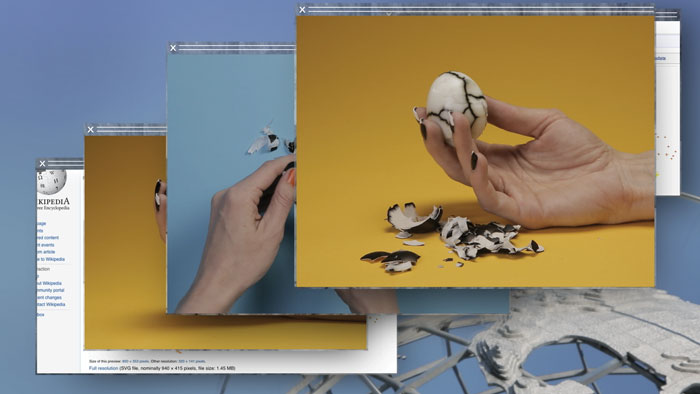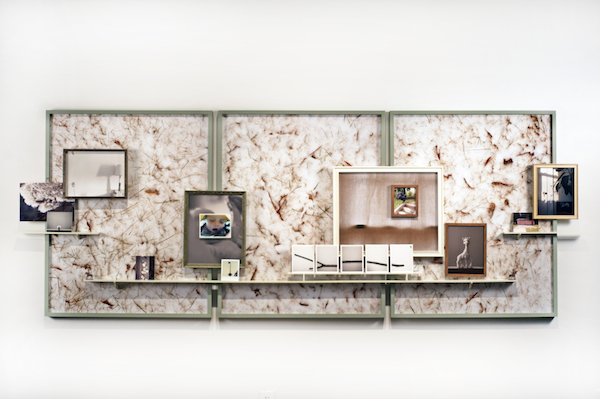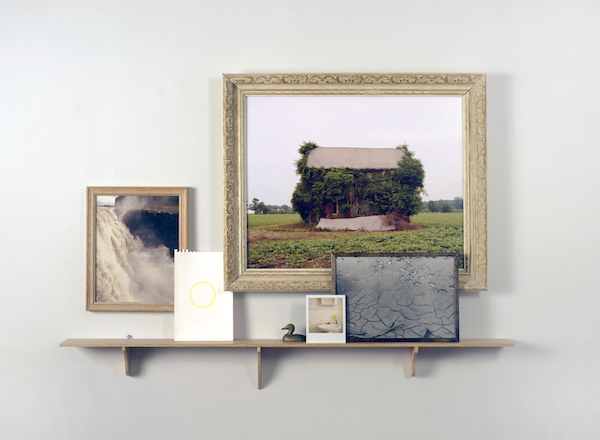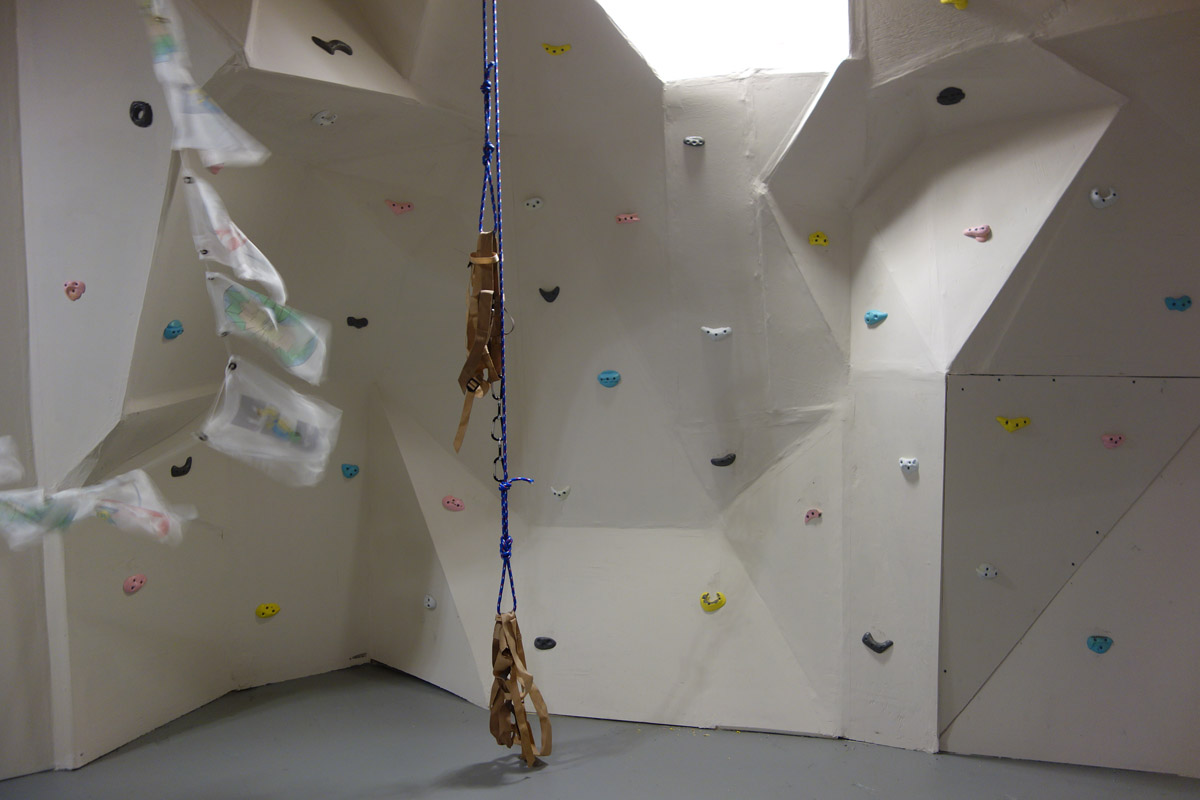Digital Consciousness and the work of Camille Henrot at the Baltimore Museum of Art and Geoff Grace at Current by Jen Coster
Everyday I scroll through images. I scroll for entertainment, I scroll for information, I scroll to communicate. Images are in an endless supply. At any time or place, I have Information, useful and superfluous, with a capital, all-inclusive, I.
A chime on my phone interrupts to deliver news and spill emotions. Windows open on my desktop to scatter thoughts and desires. Technology is continually altering my consciousness; it reshapes my perception and interaction with the world. It flattens time and space, and it layers activities and relationships.

Two Baltimore exhibitions concurrently explore the layered, scrolling consciousness of the digital age: Current Gallery presents an installation of photo combines from Geoff Grace, and the Baltimore Museum of Art screens a video from Camille Henrot.
French artist Camille Henrot addresses our current means of perceiving the world and the split consciousness of the digital age in her award winning video “Grosse Fatigue.” The video explores vast systems of knowledge and the human desire to create a cohesive image out of a fractured existence. The work was shot during a fellowship at the Smithsonian Institution, where she had access to museum archives. The result: a 13-minute video that attempts to explain the history of the creation of the world.
It begins with a familiar blank computer screen, where files are opened in a frenetic precession, layering browser windows containing Wikipedia searches, images of artifacts, and playful videos on top of each other. A spoken word poem mixed with a sampling of rhythms in the background narrates the search and encloses the viewer in a multisensory experience. The text for the poem was written as a collaboration between Henrot and the poet Jacob Bromberg by compiling lines from creation myths of ancient cultures. It is performed by Akwetey Orraca-Tetteh in the contemporary voice of hip hop. Videos open and close to the beat of the music, playfully exploring human awe and the cultural search for understanding, while juxtaposing the vast and sterile methods of classification and collection of knowledge.
Our senses are overloaded to saturation while attempting to follow the images, correlations, rhythm, and words so that we are forced to let go of linear experience. In the surrender, a wash of stimulation activates an innate response in our mind to the varied roles we encounter and evaluate daily. The 35-year-old artist received a Silver Lion award for the video at the 2013 Venice Biennale, which designates the most promising young artist, and a solo exhibition surveying her video work, works on paper, and a new installation opened at the New Museum last week.

What is striking about this video is its commercial aesthetic: The polished videos and quick cuts contain the formal qualities found in advertising, where objects are perfectly lit and cropped with clean design and bold colors. However, the artist’s performative use of poetry, rhythm, and choreography to illustrate and to obfuscate takes the viewer well beyond a simple message. Manicured hands in vibrant hues playfully activate objects and specimens. The human touch reinforces the body’s tempo within the space of the mind, and a method of learning through tactile experience.
Henrot uses recurring correlations throughout her video; the most predominant sequence links disparate elements through their shared circular shape. There is a hand methodically rolling an orange, an overhead shot of a tortoise’s round shell, dough being rolled in a modest circle, a shiny CD, a hand drawing a large repetitive O, more turtles, a circular portrait of an astronaut hangs above a crowded metro station, a screenshot of the world from space, and then the video ends with the quiet gesture of a hand rolling the orange. Dead birds, living turtles, images of space, eyeballs, and eggs are also coded to explore different elements of existence, while giving the viewer an intense dose of wonder. Even the kitschy nail polish is a curious reference to systems of knowledge. In her searches, Henrot discovered that one can find a shade of polish named after almost any word, from lighthearted to complex in meaning.

At Current Gallery, Geoff Grace uses physically built layers to explore a similar process of tracing consciousness. Both Henrot and Grace build information and imagery laterally and spatially to create visual conundrums, but while Henrot focuses on knowledge, and the understanding of existence through intellect, Grace’s installations resonate on an emotional level, mapping a trajectory of moods and sensations within the cycles of personal experience.
Geoff Grace fills both rooms of Current Gallery with sprawling wall-mounted photo combinations in his solo show, “dreams before dawn.” The Baltimore artist received the 2008 Sondheim grand prize and has been active in the community for the past decade as an artist, musician, and teacher. This is the first substantive solo exhibit of his work in many years.
In Grace’s photo installations, framed photos float over each other and shelves are mounted on top of photos to hold smaller images and keepsakes. The physical presence of the layers and the warmth of the images allude to domestic space and a collection of personal experiences. As Bret McCabe writes in the catalogue’s introductory essay, “It’s as if each photo arrangement is a visual rebus that unlocks the combination lock to a memory door in the brain that you didn’t know was there. Memories come tumbling out, and they wash over you in confounding emotional waves because they’re so nonspecifically potent, like primary colors: happy, sad, desire, loss.”
The images work on an intuitive level, and our minds naturally search for cohesion, but the combines represent a mindscape, rather than a narrative. Grace plays with an overlapping sense of time, exploring how memories influence experience as it is happening and how memories are catalogued and recalled. “Its just how I experience the world, with different times always existing side by side, when I go to get a sandwich or do anything. It’s the power of memory and the power of memories that aren’t even your own, they’re in the culture and the objects and the stuff of the world.”

In the installation “where water comes together with other water,” there is an overarching theme following cycles of water, but each frame on its own is a familiar moment, a simple gesture, or poetic fodder for contemplation. The combine contains a series of coded images: an energetic waterfall, chaotic and power; a house overgrown with trees and vines containing the opposite forces of decay and vitality; a detail of the ground, where muddy footprints hold small ephemeral puddles; a polaroid of a domestic bathroom sink bathed in sunlight; a small but weighted tchotchke brass duck; a hand drawn yellow circle on note paper. Grace carefully weaves together strength, regeneration, nuance, domestication, and the symbolic with quiet discovery.
All of the images in the show were shot by Grace, with a variety of methods including camera phone, polaroid, view camera and other traditional camera bodies, save for one or two found photos. The photos are arranged balancing formal elements and emotive responses. Grace elaborates in the catalog, “The feeling that I’m looking for in general, not just in taking these pictures but in making the final pieces and my other installations and work, is a charged stillness, where things have a momentary stability but there’s a sense that things are swerving in and out, even if the objects are relatively stationary.”
An example of this phenomenon can be found in “Buttons,” where a black and white sentimental portrait of his daughter is blocked out by a small but direct cell phone image of her sleeping on a plane with her mouth open. The first image is overly idealized art photography with a timeless quality, the second is raw 21st century reality. The images contrast while being the same, and record a temporary moment both precious and common.
Where Henrot accumulates object associations in a sped up digital time, Grace trusts revelations found in an analog patience. Both artists aim to explore the internal mechanisms for understanding the external world, to explore how time and technology create a layered experience. Henrot seductively catalogs objects in a quirky but commercial design, highlighting our desire for knowledge, cohesion and an intellectual stability. But with a considered wit she unravels her own thesis, showing the futility in putting together a universal explanation, and accepting the chaotic elements that even technology cannot control.
For Grace, the layering of images provides a still depth rather than a frantic exhaustion. The physicality of the works has an anchoring quality, as we are able to explore them at our own leisure, striking a balance to the ephemeral features of the images. Grace has developed a clever and seamless approach to preserve the fleeting moments we hold internally, so that we may linger on associations that normally wash over our minds instantly without leaving a trace. In both the works of Henrot and Grace, we marvel in our own mind’s ability to instantly catalogue and sort through vastly different experiences as we encounter and inhabit varied roles, which are made increasingly complex through our changing relationship to technology.
*Geoff Grace’s “dreams before dawn” is up at Current Gallery until May 25th
421 N Howard, gallery hours, Saturday and Sunday 12-4
There is a catalog of the show available for purchase for $15
*Camille Henrot’s “Gross Fatigue” screens at the BMA’s black box theatre until June 15th
*Camille Henrot’s “The Restless Earth” featuring “Gross Fatigue” and other videos, works on paper and installation is on view at the New Museum until June 29th
** Author Jennifer Coster is an artist living in Baltimore. In 2012 she received an MFA from MICA and founded the publication Print/Collect.






